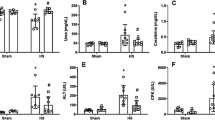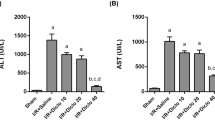Abstract
Leukocytes, in particular polymorphonuclear neutrophils (PMNs), are believed to play a central role in ischemia-reperfusion (I/R)-induced tissue injury. Changes in endothelial cells occurring during ischemia promote PMN binding to these cells during reperfusion, which primes PMN synthesis of oxygen radicals and release of cytotoxic proteins. These events lead to vascular damage and subsequent tissue injury. Recently we have shown that doxycycline (Dc), a member of the tetracycline family of antibiotics, inhibits PMN superoxide (O2) synthesis and degranulation in vitro. It also suppresses PMN-mediated RBC, fibroblast, and endothelial cytotoxicity, properties of the drug that may make it of use to protect tissues from I/R-induced injury. In this study we demonstrate that Dc administration either prior to clamping of the portal circulation, or 1 h after the reperfusion, significantly suppressed liver damage as assessed by serum levels of a marker of hepatic injury, alanine aminotransferase (s-ALT). The reduction in s-ALT was not a result of reduced reflow in the Dc-treated rats as indicated by Evans' blue perfusion data. The findings suggest that Dc and possibly other tetracyclines may be of value in protecting tissues and organs from I/R-mediated damage even if the drug is given after the ischemic event has occurred.
Similar content being viewed by others

References
Jaeschke, H., andA. Farhood. 1991. Neutrophil and Kupffer cell-induced oxidant stress and ischemia-reperfusion injury in rat liver.Am. J. Physiol. 260:G355.
Jaeschke, H., A. Farhood, andC. W. Smith. 1990. Neutrophils contribute to ischemia/reperfusion injury in rat liver in vivo.FASEB J. 4:3355.
Jaeschke, H. 1991. Reactive oxygen and ischemia/reperfusion injury of the liver.Chem. Biol. Interact. 76:115.
Itoh, T., M. Kawakami, Y. Yamauchi, S. Shimizu, andM. Nakamura. 1986. Effect of allopurinol on ischemia and reperfusion induced cerebral injury in spontaneously hypertensive rats.Stroke 17:1284.
Parks, D. A., andD. N. Granger. 1983. Oxygen-derived radicals and ischemia-reperfusion induced tissue injury.In Oxy Radicals and Their Scavenger Systems II. Cellular and Medical Aspects. R.A. Greenwald and G. Cohen, editors. Elsevier Science/North-Holland, New York. 135.
Mileski, W. J., R. K. Winn, N. B. Vedder, T. H. Pohlman, J. M. Harlan, andC. L. Rice. 1990. Inhibition of DC 18-dependent neutrophil adherence reduces organ injury after hemorrhagic shock in primates.Surgery 108:206.
Entman, M. L., L. Michael, R. D. Rossen, W. J. Dreyer, D. C. Anderson, A. A. Taylor, andC. W. Smith. 1991. Inflammation in the course of early myocardial ischemia.FASEB J. 5:2529.
Klausner, J. M., I. S. Patrson, G. Goldman, L. Kobzik, C. Rodzen, R. Lawrence, C. R. Valeri, D. Shepro, andH. B. Hechtman. 1989. Postischemic renal injury is mediated by neutrophils and leukotrienes.Am. J. Physiol. 256:F794.
Nathan, C., S. Srimal, C. Farber, E. Sanchez, L. Kabbash, A. Asch, J. Gailit, andS. D. Wright. 1989. Cytokine-induced respiratory burst of human neutrophils. Dependence on extracellular matrix proteins and CD11/CD18 integrins.J. Cell Biol. 109:1341.
Gabler, W. L., andH. R. Creamer. 1991. Suppression of human neutrophil functions by tetracyclines.J. Periodont. Res. 26:52.
Gabler, W. L., andN. Tsukuda. 1991. The influence of divalent cations and doxycycline on iodoacetamide-inhibitable leukocyte adherence.Res. Commun. Chem. Pathol. Pharmacol. 74(2):131.
Romson, J. L., B. G. Hook, S. L. Kunkel, G. D. Abrams, M. A. Schork, andB. R. Lucchesi. 1983. Reduction of extent of ischemic myocardial injury by neutrophil depletion in the dog.Circulation 67(5):1016.
Lucchesi, B. R., W. E. Burmeister, T. E. Lomas, andG. D. Adams. 1976. Ischemic changes in the canine heart as affected by the dimethyl quaternary analog of propranolol, UM-272 (SC-27761).J. Pharmacol. Exp. Ther. 199(2):310.
Stine, E. R., L. Gunawardhana, andI. G. Sipes. 1991. The acute hepatotoxicity of the isomers of dichlorobenzene in Fischer-344 and Sprague-Dawley rats: Isomer-specific and strain specific differential toxicity.Toxicol. Appl. Pharmacol 109(3):472.
Jaeschke, H., A. Farhood, A. P. Bautista, Z. Spolaries, J. J. Spitzer, andC. W. Smith. 1993. Functional inactivation of neutrophils with a Mac-1(CD11b/CD18) monoclonal antibody protects against ischemia-reperfusion injury in rat liver.Hepatology 17:915.
Belsheim, J., C. Blomquist, J. Lofberg, andH. Gnarpe. 1983. Tetracycline influence on leukocyte functions.Acta Oto-Rhino-Laryngol. Bel. 37:635.
Charo, I. F., C. Yuen, andI. M. Goldstein. 1985. Adherence of human polymorphonuclear leukocytes to endothelial monolayers: Effects of temperature, divalent cations and chemotactic factors on the strength of adherence.Blood 65:473.
Arnaout, A. 1990. Structure and function of leukocyte adhesion molecules CD 11/CD 18.Blood 75(5):1037.
Patarroyo, M., J. Prieto, J. Rincon, T. Timonen, C. Lundberg, L. Lindblom, B. Asjo, andC. G. Gahmberg. 1990. Leukocyte-cell adhesion: A molecular process fundamental in leukocyte physiology.Immunol. Rev. 114:67.
W. L. Gabler, 1990. Potential roles of Mg2+ and Ca2+ in NADPH oxidase dependent superoxide anion synthesis by human neutrophils.Res. Commun. Chem. Pathol. Pharmacol. 70(2):213.
Clark, R. A., K. G. Leidal, D. W. Pearson, andW. M. Nauseef. 1987. NADPH oxidase in human neutrophils. Subcellular location and characterization of an arachidonate-activatable superoxide-generating system.J. Biol. Chem. 262:4065.
Babior, B. M., R. Kuver, andJ. T. Curnutte. 1988. Kinetics of activation of the respiratory burst oxidase in fully soluble system from human neutrophils.J. Biol. Chem. 263(4):1713.
Varani, J., S. E. G. Fligiel, G. O. Till, R. G. Kunkel, U. S. Ryan, andP. A. Ward. 1985. Pulmonary endothelial cell killing by human neutrophils. Possible involvement of hydroxyl radicals.Lab. Invest. 53:656.
Ward, P. A., G. O. Till andC. Beauchamp. 1983. Evidence for role of hydroxyl radical in complement and neutrophil-dependent tissue injury.J. Clin. Invest. 72:789.
Guigui, B., J. Rosenbaum, A. Preaux, N. Martin, E. S. Zafrani, D. Dhumeaux, andP. Mavier. 1988. Toxicity of phorbol myristate acetate-stimulated polymorphonuclear neutrophils against rat hepatocytes.Lab. Invest. 59(6):831.
Weiss, S. J. 1989. Tissue destruction by neutrophils.N. Engl. J. Med. 320:365.
Weiss, S. J., andG. J. Peppin. 1986. Collagenolytic metalloenzymes of human neutrophil: Characteristics regulation and potential functions in vivo.Biochem. Pharmacol. 35:3189.
Travis, J., andG. S. Salvensen. 1983. Human plasma proteinase inhibitors.Annu. Rev. Biochem. 52:655.
Wasil, M., B. I. Halliwell, andC. P. Moorhouse. 1981. Scavengering of hypochlorous acid by tetracycline, rifampicin and some other antibiotics: A possible antioxidant action of rifampicin and tetracycline.Biochem. Pharmacol. 37(4):775.
Golub, L. M., N. Ramamurthy, T. F. McNamara, et al. 1984. Tetracyclines inhibit tissue collagenase activity.J. Periodont. Res. 19:651.
Zucker, S., R. M. Lysik, N. S. Ramamurthy, et al. 1985. Diversity of melanoma plasma membrane proteinases: Inhibition of collagenolytic and cytolytic activities by minocycline.J. Natl. Cancer Inst. 75:517.
Author information
Authors and Affiliations
Additional information
This research was supported by grants from the Kettering Foundation and the Medical Research Foundation of Oregon
Rights and permissions
About this article
Cite this article
Smith, J.R., Gabler, W.L. Doxycycline suppression of ischemia-reperfusion-induced hepatic injury. Inflammation 18, 193–201 (1994). https://doi.org/10.1007/BF01534560
Issue Date:
DOI: https://doi.org/10.1007/BF01534560



